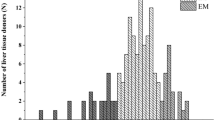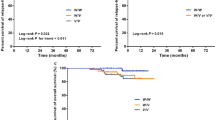Abstract
Purpose
CYP2C19 contributes to the metabolism of several chemotherapeutic agents. The CYP2C19 homozygous null function genotype strongly predicts activity phenotype in healthy populations. An additional acquired loss of function has been reported in up to one-third of cancer patients. It is not known whether this phenomenon also occurs in patients with earlier stage or in resected disease.
Methods
This study investigated whether acquired loss of CYP2C19 function was detectable in patients with stage III–IV or resected gastrointestinal cancer. CYP2C19 genotype was determined in 49 patients, and subjects were probed for CYP2C19 activity on three test occasions.
Results
An acquired loss of CYP2C19 activity was observed in 20 % of stage III–IV and 17 % of resected patients at the first test. Significant (p < 0.01) genotype–phenotype discordance was observed in both groups. There were no direct associations between this discordance and inflammatory markers, tumour burden or chemotherapeutic history. Notably, hepatic CYP2C19 function was not stable over time and phenotype conversion occurred in 23 patients over the period of testing.
Conclusion
Reliance on germ-line genotype to infer a poor metaboliser status could substantially underestimate the number of patients with deficient CYP2C19 function. This could compromise the interpretation of genotype-based clinical association studies.


Similar content being viewed by others
References
Desta Z, Zhao X, Shin JG, Flockhart DA (2002) Clinical significance of the cytochrome P450 2C19 genetic polymorphism. Clin Pharmacokinet 41:913–958
Chiba K, Kobayashi K, Manabe K, Tani M, Kamataki T, Ishizaki T (1993) Oxidative metabolism of omeprazole in human liver microsomes: cosegregation with S-mephenytoin 4′-hydroxylation. J Pharmacol Exp Ther 266(1):52–59
Kim KA, Park PW, Hong SJ, Park JY (2008) The effect of CYP2C19 polymorphism on the pharmacokinetics and pharmacodynamics of clopidogrel: a possible mechanism for clopidogrel resistance. Clin Pharmacol Ther 84(2):236–242
Ando Y, Fuse E, Figg WD (2002) Thalidomide metabolism by the CYP2C subfamily. Clin Cancer Res 8(6):1964–1973
Coller JK, Krebsfaenger N, Klein K, Endrizzi K, Wolbold R, Lang T, Nüssler A, Neuhaus P, Zanger UM, Eichelbaum M, Mürdter TE (2002) The influence of CYP2B6, CYP2C9 and CYP2D6 genotypes on the formation of the potent antioestrogen Z-4-hydroxy-tamoxifen in human liver. Br J Clin Pharmacol 54(2):157–167
Helsby NA, Hui CY, Goldthorpe MA, Coller JK, Soh MC, Gow PJ, De Zoysa JZ, Tingle MD (2010) The combined impact of CYP2C19 and CYP2B6 pharmacogenetics on cyclophosphamide bioactivation. Br J Clin Pharmacol 70(6):844–853
Horsmans Y, Lannes D, Larrey D, Tinel M, Letteron P, Loeper J, Pessayre D (1991) Nilutamide inhibits mephenytoin 4-hydroxylation in untreated male rats and in human liver microsomes. Xenobiotica 21(12):1559–1570
Li Y, Hou J, Jiang H, Wang D, Fu W, Yuan Z, Chen Y, Zhou L (2007) Polymorphisms of CYP2C19 gene are associated with the efficacy of thalidomide-based regimens in multiple myeloma. Haematologica 92(9):1246–1249
Ruan C-J, Liu D-Y, Jiang J, Hu P (2012) Effect of the CYP2C19 genotype on the pharmacokinetics of icotinib in healthy male volunteers. Eur J Clin Pharmacol 68(12):1677–1680
Schroth W, Antoniadou L, Fritz P, Schwab M, Muerdter T, Zanger UM, Simon W, Eichelbaum M, Brauch H (2007) Breast cancer treatment outcome with adjuvant tamoxifen relative to patient CYP2D6 and CYP2C19 genotypes. J Clin Oncol 25(33):5187–5193
Timm R, Kaiser R, Lotsch J, Heider U, Sezer O, Weisz K, Montemurro M, Roots I, Cascorbi I (2005) Association of cyclophosphamide pharmacokinetics to polymorphic cytochrome P450 2C19. Pharmacogenomics J 5(6):365–373
Uttamsingh V, Lu C, Miwa G, Gan L-S (2005) Relative contributions of the five major human cytochromes P450, 1A2, 2C9, 2C19, 2D6, and 3A4, to the hepatic metabolism of the proteasome inhibitor bortezomib. Drug Metab Dispos 33(11):1723–1728
Yamamoto N, Murakami H, Nishina T, Hirashima T, Sugio K, Muro K, Takahashi T, Naito T, Yasui H, Akinaga S (2013) The effect of CYP2C19 polymorphism on the safety, tolerability, and pharmacokinetics of tivantinib (ARQ 197): results from a phase I trial in advanced solid tumors. Ann Oncol 24(6):1653–1659
Zandvliet AS, Huitema ADR, Copalu W, Yamada Y, Tamura T, Beijnen JH, Schellens JH (2007) CYP2C9 and CYP2C19 polymorphic forms are related to increased indisulam exposure and higher risk of severe hematologic toxicity. Clin Cancer Res 13(10):2970–2976
Baldwin RM, Ohlsson S, Pedersen RS, Mwinyi J, Ingelman-Sundberg M, Eliasson E, Bertilsson L (2008) Increased omeprazole metabolism in carriers of the CYP2C19*17 allele; a pharmacokinetic study in healthy volunteers. Br J Clin Pharmacol 65(5):767–774
Goldstein JA, Blaisdell J (1996) Genetic tests which identify the principal defects in CYP2C19 responsible for the polymorphism in mephenytoin metabolism. Methods Enzymol 272:210–218
Sanford JC, Guo Y, Sadee W, Wang D (2013) Regulatory polymorphisms in CYP2C19 affecting hepatic expression. Drug Metabol Drug Interact 28(1):23–30
Sim SC, Risinger C, Dahl ML, Aklillu E, Christensen M, Bertilsson L, Ingelman-Sundberg M (2006) A common novel CYP2C19 gene variant causes ultrarapid drug metabolism relevant for the drug response to proton pump inhibitors and antidepressants. Clin Pharmacol Ther 79(1):103–113
Xie HG, Kim RB, Wood AJJ, Stein CM (2001) Molecular basis of ethnic differences in drug disposition and response. Annu Rev Pharmacol Toxicol 41(1):815–850
Sistonen J, Fuselli S, Palo JU, Chauhan N, Padh H, Sajantila A (2009) Pharmacogenetic variation at CYP2C9, CYP2C19, and CYP2D6 at global and microgeographic scales. Pharmacogenet Genom 19(2):170–179
Xie HG, Stein CM, Kim RB, Wilkinson GR, Flockhart DA, Wood AJ (1999) Allelic, genotypic and phenotypic distributions of S-mephenytoin 4′-hydroxylase (CYP2C19) in healthy Caucasian populations of European descent throughout the world. Pharmacogenetics 9(5):539–549
Helsby NA (2008) Pheno-or genotype for the CYP2C19 drug metabolism polymorphism: the influence of disease. Proc West Pharmacol Soc 51:5–10
Williams ML, Bhargava P, Cherrouk I, Marshall JL, Flockhart DA, Wainer IW (2000) A discordance of the cytochrome P450 2C19 genotype and phenotype in patients with advanced cancer. Br J Clin Pharmacol 49(5):485–488
Helsby NA, Lo WY, Sharples K, Riley G, Murray M, Spells K, Dzhelai M, Simpson A, Findlay M (2008) CYP2C19 pharmacogenetics in advanced cancer: compromised function independent of genotype. Br J Cancer 99(8):1251–1255
Burns KE, Goldthorpe MA, Porteus F, Browett P, Helsby NA (2014) CYP2C19 genotype–phenotype discordance in patients with multiple myeloma leads to an acquired loss of drug-metabolising activity. Cancer Chemother Pharmacol 73(3):651–655
Kim S, Östör AK, Nisar M (2012) Interleukin-6 and cytochrome-P450, reason for concern? Rheumatol Int 32(9):2601–2604
Morgan ET, Goralski KB, Piquette-Miller M, Renton KW, Robertson GR, Chaluvadi MR, Charles KA, Clark Kacevska M, Liddle C, Richardson TA, Sharma R, Sinal CJ (2008) Regulation of drug-metabolizing enzymes and transporters in infection, inflammation, and cancer. Drug Metab Dispos 36(2):205–216
Rivory LP, Slaviero KA, Clarke SJ (2002) Hepatic cytochrome P450 3A drug metabolism is reduced in cancer patients who have an acute-phase response. Br J Cancer 87(3):277–280
Frye RF, Schneider VM, Frye CS, Feldman AM (2002) Plasma levels of TNF-α and IL-6 are inversely related to cytochrome P450-dependent drug metabolism in patients with congestive heart failure. J Card Fail 8(5):315–319
Matthys P, Billiau A (1997) Cytokines and cachexia. Nutrition 13(9):763–770
Helsby NA, Ward SA, Edwards G, Howells RE, Breckenridge AM (1990) The pharmacokinetics and activation of proguanil in man: consequences of variability in drug metabolism. Br J Clin Pharmacol 30(4):593–598
Herrlin K, Massele AY, Rimoy G, Alm C, Rais M, Ericsson Ö, Bertilsson L, Gustafsson LL (2000) Slow chloroguanide metabolism in Tanzanians compared with white subjects and Asian subjects confirms a decreased CYP2C19 activity in relation to genotype. Clin Pharmacol Ther 68(2):189–198
Eisenhauer EA, Therasse P, Bogaerts J, Schwartz LH, Sargent D, Ford R, Dancey J, Arbuck S, Gwyther S, Mooney M, Rubinstein L, Shankar L, Dodd L, Kaplan R, Lacombe D, Verweij J (2009) New response evaluation criteria in solid tumours: revised RECIST guideline (version 1.1). Eur J Cancer 45(2):228–247
Therasse P, Arbuck SG, Eisenhauer EA, Wanders J, Kaplan RS, Rubinstein L, Verweij J, Van Glabbeke M, van Oosterom AT, Christian MC (2000) New guidelines to evaluate the response to treatment in solid tumors. J Natl Cancer Inst 92(3):205–216
Gurney JM, Jelliffe DB (1973) Arm anthropometry in nutritional assessment: nomogram for rapid calculation of muscle circumference and cross-sectional muscle and fat areas. Am J Clin Nutr 26(9):912–915
Norman K, Kirchner H, Lochs H, Pirlich M (2006) Malnutrition affects quality of life in gastroenterology patients. World J Gastroenterol 12(21):3380–3385
Reid IR, Evans MC, Ames R (1992) Relationships between upper-arm anthropometry and soft-tissue composition in postmenopausal women. Am J Clin Nutr 56:463–466
Lo WY (2011) Studies to understand the effect of cancer on hepatic CYP2C19 activity. PhD Thesis, The University of Auckland, Auckland
Lanchote VL, Almeida R, Barral A, Barral‐Netto M, Marques MP, Moraes NV, Silva AM, Souza T, Suarez‐Kurtz G (2015) Impact of visceral leishmaniasis and curative chemotherapy on cytochrome P450 activity in Brazilian patients. Br J Clin Pharmacol 80(5):1160–1168
Shah RR, Smith RL (2015) Addressing phenoconversion: the Achilles’ heel of personalized medicine. Br J Clin Pharmacol 79(2):222–240
Shah RR, Smith RL (2015) Inflammation-induced phenoconversion of polymorphic drug metabolizing enzymes: a hypothesis with implications for personalized medicine. Drug Metab Dispos 43(3):400–410
Alexandre J, Rey E, Girre V, Grabar S, Tran A, Montheil V, Rabillon F, Dieras V, Jullien V, Hérait P, Pons G, Treluyer JM, Goldwasser F (2007) Relationship between cytochrome 3A activity, inflammatory status and the risk of docetaxel-induced febrile neutropenia: a prospective study. Ann Oncol 18(1):168–172
Baker SD, van Schaik RHN, Rivory LP, Ten Tije AJ, Dinh K, Graveland WJ, Schenk PW, Charles KA, Clarke SJ, Carducci MA, McGuire WP, Dawkins F, Gelderblom H, Verweij J, Sparreboom A (2004) Factors affecting cytochrome P-450 3A activity in cancer patients. Clin Cancer Res 10(24):8341–8350
Shord SS, Cavallari LH, Viana MA, Momary K, Neceskas J, Molokie RE, Deyo K, Patel SR (2008) Cytochrome P450 2C9 mediated metabolism in people with and without cancer. Int J Clin Pharmacol Ther 46(7):365–374
de Graan A-JM, Teunissen SF, de Vos FY, Loos WJ, van Schaik RH, de Jongh FE, de Vos AI, van Alphen RJ, van der Holt B, Verweij J (2011) Dextromethorphan as a phenotyping test to predict endoxifen exposure in patients on tamoxifen treatment. J Clin Oncol 29(24):3240–3246
Acknowledgments
This study was funded by the Genesis Oncology Trust and the University of Auckland. We wish to thank the research nurses Georgia Wilson, Michelle Davidson and Karen Spells for their help with patient recruitment. This work has previously been reported as a poster at the AACR Annual Meeting 2014; April 5–9, 2014; San Diego, CA, USA [Cancer Res 74 (19 Supplement):5548].
Author information
Authors and Affiliations
Corresponding author
Ethics declarations
Conflict of interest
None.
Electronic supplementary material
Below is the link to the electronic supplementary material.
Rights and permissions
About this article
Cite this article
Burns, K.E., Lo, WY., Findlay, M.P. et al. High CYP2C19 phenotypic variability in gastrointestinal cancer patients. Cancer Chemother Pharmacol 77, 195–204 (2016). https://doi.org/10.1007/s00280-015-2923-4
Received:
Accepted:
Published:
Issue Date:
DOI: https://doi.org/10.1007/s00280-015-2923-4




